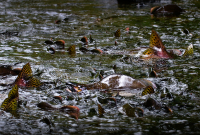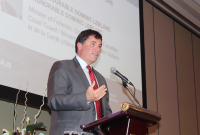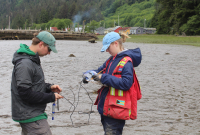Support strong Canadian climate journalism for 2025
It was two degrees below freezing on a November morning in Montreal and some residents were still strolling around in sweaters and sneakers. But Suzanne Labbé and Pierre Bannon were decked out in puffy parkas, hiking boots and mittens. A camera with a foot-long lens extension hung on Labbé’s neck and a heavy tripod with a nifty set of binoculars was slung around Bannon’s shoulders.
Labbé and Bannon are what researchers call "citizen scientists" and they were off to take photos of birds. The retired couple contribute thousands of entries to eBird, a database of millions of observations submitted by bird watchers around the world. The database is public, which in turn helps scientists do research and design conservation solutions.
Citizen science allows volunteers like Labbé and Bannon to engage directly with researchers and learn about emerging studies by collecting the much-needed data and evidence used by scientists. Many scientists from non-profit groups, universities and governments around the world are now using this type of crowd-sourced data. They say it allows them to overcome limited budgets and document significant changes that humans are causing to ecosystems.
Everyone has a stake in the outcomes of science, says Jeremy Kerr
While popular culture has brought science into the mainstream with television sitcoms such as The Big Bang Theory, researchers say citizen science offers hands-on experience to members of the public.
Jeremy Kerr, a professor of biology from the University of Ottawa, even compares the emergence of citizen science to the hit TV series, explaining that popular comedy shows and the rise of the Internet are part of what is making science more accessible and entertaining.
"Science is fun to learn about, filled with very human stories, and everyone has a stake in the outcomes."
Kerr has used citizen science for some of his research on biodiversity and the decline of butterflies and bumble bees in North America.
Even when his daughter observes the movement of butterflies, Kerr sees this as a form of citizen science.
"Citizen science shows conclusively that discovery is not the province of remote, ivory tower elites. That is a stereotype from a half century ago. It is something that anyone can be part of and that will benefit everyone," Kerr told National Observer in an interview.

He said that the butterflies thrive better than bumble bees in the new climate. The change is important to document and analyze, because bumble bees are pollinators. A good 75 per cent of crops rely on pollination to grow, he said.
So the new data has allowed Kerr to pinpoint which key areas need protection, and none of it would have been possible without citizen science.
"Canada, for example, is 10 million square kilometres. And if species are moving around across a geographical area that big, scientists cannot measure the change very quickly because we just can't get to all those places very fast. But citizen scientists are able to help with that because they're all over the place and so they can get to places and tell us about changes before we ever know ourselves," he said.
Kerr, who delivered the same message to a group of politicians, media and fellow scientists on Parliament Hill in October, explained that anyone can participate simply by using a smartphone to document the place and time of their nature sighting and uploading it to a website.
"It's a very easy step from somebody who just looks at nature to somebody who contributes data," he had said. "If people who are actually interested in a group of organisms that the program is built on, like butterflies, then you get a lot of data and a lot of good quality data quickly. So we can measure on a continental scale what's going on," he said enthusiastically during his presentation.
Biologists have had their boots on the ground for decades
Kerr has co-founded two websites similar to eBird, that allow users to upload information, including photos and the location of bumble bees and butterflies – Bumble Bee Watch and eButterfly.
He said that 75 to 100 years ago, biologists did research the traditional way – boots on the ground, trudging across the country collecting baseline information on species. The data they collected in the past has allowed Kerr to see what is happening now as species cope with warmer weather and climate change.
Kerr added that aside from climate change, other human activities also heavily affect the survival of the endangered bumble bee in North America. "In some places where people have removed habitats very extensively, landscapes are very disconnected. It's hard for organisms to move from one place to another. There's no roads for them to travel on, their habitats are all chopped up. We can connect them again if we know something about the capacity of those species to move around," he said.
Scientists like Richard Schuster, who is doing post-doctoral research in biology at Carleton University, said he uses citizen science for his research on the decline of North American birds – as some species are too small to be monitored with electronic tags and the areas they use for migration are too large for him to track with a group of students in the field. He has looked into observations of 73 bird species in southwestern B.C., Washington, and Oregon on eBird and used scientific predictions of migrations to figure out where certain species are likely to be. He said that eBird motivates its users by offering monthly prizes such as a high quality set of binoculars to get them to document birds in certain areas lacking data.
Back in Montreal at the Parc des Rapides, Labbé and Bannon can identify some birds without even peeping into their binoculars. "Those are Hooded Mergansers," the couple said practically in sync, pointing to a raft of about a dozen ducks probably 50 feet away. In the span of 20 minutes, they spotted nine different species on what they described as a quiet day.

"We complement each other," said Labbé, a retired human resources manager, who takes high-resolution, well composed photos of the birds while Bannon, a former biochemist, identifies the species using 40 years of experience bird watching. Labbé said they are proud to be able to travel around the world and contribute to science.
Just last summer, they uploaded photos of their sightings in Spain – and added to eBird’s data in Europe, which has less submissions than North America, she noted. Indeed, the website noted over 500,000 listings in Europe, which pales in comparison to the almost 18 million listed for North America.
Bannon opened the French version of the eBird app on his smartphone, selected his location with the GPS system and swiftly chose the names of the birds immediately upon each sighting. That’s precisely what eBird banks on – the fact that bird watchers like to document what they see.
"It's a mutual relationship, where everybody benefits. Originally we tried, when eBird first started in 2002, it had the tag line 'birding with a purpose,' you can help science, you can help research, you can help conservation. [But] eBird went nowhere," said Wesley Hochachka, the assistant director of Bird Population Studies at the Lab of Ornithology for Cornell University, which created the app and website.
After the eBird founders realized the database was ineffective, they hired three international bird tour guides, who advised them to make the program more user-friendly. "'You're looking at it all wrong. You got to make this about something bird watchers want to do,' [the three told eBird staff]. And they talked about redesigning and creating these tools for bird watchers and then we did. And basically continued at exponential growth. We're taking advantage of a latent interest in [people already] doing the work," Hochachka said.
Making inroads for conservation
In Ryder Lake, B.C., a non-profit group actually redesigned a roadway. It created a pathway for frogs, toads and salamanders to cross the road safely, after finding out through citizen science data that many amphibians died as road kill. The data was collected through a provincial program, partially funded by the government, called B.C. Frogwatch. "They (the Fraser Valley Conservancy) were able to install fences and a ‘toad tunnel.’ So the toads now travel underneath the road," Purnima Govindarajulu, a scientist with the BC Ministry of Environment, said.
The Conservancy notes on its website that adult Western toads have to cross the road seasonally to migrate for breeding in the spring. Govindarajulu said that because locals got so involved in tracking the amphibians, some residents have mobilized to pick up the toadlets and walk them across the road, releasing them on the other side, in a bucket brigade. "So there are some very on the ground conservation actions that have taken place [from citizen science]," she noted.
Wendy Palen, a scientist and professor at Simon Fraser University in Vancouver, has also used data from Frogwatch to track an invasive frog species. With her students, the Palen Lab has published a paper on the American Bullfrog, which has been blamed for the decline of some bird and amphibian species all around the world, and is prevalent in B.C. Palen praised the work of citizen scientists, who she sees as "doing a recreational activity and contributing to something bigger."
However, Palen also acknowledged that there are limits to using citizen science data for research. The obvious one is that they are not actually scientists. "So, often times, the citizen science data that we're using is relying on their own knowledge of the topic. So, for example, for bird watchers, we're relying on them knowing the identity of the birds and self-reporting their location," she said.
She also noted the limitations in terms of doing research with microscopic species. "We do a lot of work with stream macroinvertebrates — so the insects develop for part of their life cycle in streams — there are, in any stream that you might go to in Canada, several hundred species. To the common observer, you might be able to pick out maybe a dozen that might look different from each other and so going further than that, requires real expertise in understanding the taxonomy and differences among species that often requires microscopes and high levels of training of examining particular body parts. So that's not something that a citizen scientist can do or be expected to do."
Palen said that not many scientists rely solely on citizen science data for their research. But their information has allowed ecologists to do work that would otherwise be impossible, where scientists are limited by time, resources and funding.
‘Natural historians’
Stephanie Green, a Canadian marine ecologist who is doing post-doctoral research at Stanford University, said the volunteer work of nature lovers is especially useful in studying life underwater. She’s used citizen science data collected by the Reef Environmental Education Foundation (REEF) to study the impacts of the venomous lionfish, an Indo-Pacific invasive species that’s made its way into Florida and the Caribbean.

"Citizen scientists were the first to document the invasion and we've used their data from fish surveys to understand how quickly the populations of lionfish have increased," said Green, who is previously studied at Simon Fraser University in British Columbia. The volunteers have gone on scuba diving trips in Florida, Bahamas, Virgin Islands and Puerto Rico with scientists like herself and others with REEF. Together, they removed lionfish from core reef environments, gathered biological samples and used fish surveys to help understand the impact of the invasions.
Like Palen and Kerr, Green said because of the scale of the research and the geographical area she had to cover for her research, it would have been impossible to get the surveys done.
Green said citizen science could help the Liberal government meet its goal of protecting oceans. According to the party’s statement on its website, "We will increase the amount of Canada’s marine and coastal areas that are protected from 1.3 percent to five percent by 2017, and 10 per cent by 2020."
"We’re not there yet and I think by engaging citizen scientists in things like monitoring and documenting, it might be a key way to help us get some of the information that we need that we won't be able to at the same scale," Green said.
All science matters, says office of Science Minister Kirsty Duncan
The federal government says it supports all sciences, including citizen science.
"We believe that all science matters and that facts and data should inform decision-making," said Duncan's spokeswoman Véronique Perron in an email to National Observer. "Our government encourages all Canadians to take part in sciences, technology, engineering and mathematics. Our ability to innovate, make new discoveries, and find solutions to the most pressing issues depends on the participation and support of everyone."
Green said it's time to tap into citizen scientists' talents. "I would say some are more knowledgeable than scientists who've had deep training in some of these topics because they're really keen, natural historians. They know a lot about the environment and they've often been out in the field looking at species and have a lot of experience," Green said adamantly.
That's definitely the case for Suzanne Labbé and Pierre Bannon, who could easily be mistaked for professional ornithologists. Labbé’s eBird profile boasts 1,371 species identified around the world.
However, asked if they would contribute to eBird even if there were no conservation efforts that came out of the project – if it was purely recreational – the couple said yes immediately.

"Yeah, because it's fun you know. It's fun to register all our data in a system," Bannon said. "Also, there's an informal competition between the users," Labbé said. "When there's a rare bird somewhere, everyone will go... everyone will see. You'll see other eBirders there. It was a joke within the community, when Pokemon got popular, everyone was like, 'well, we've been doing it for years!'"







Comments